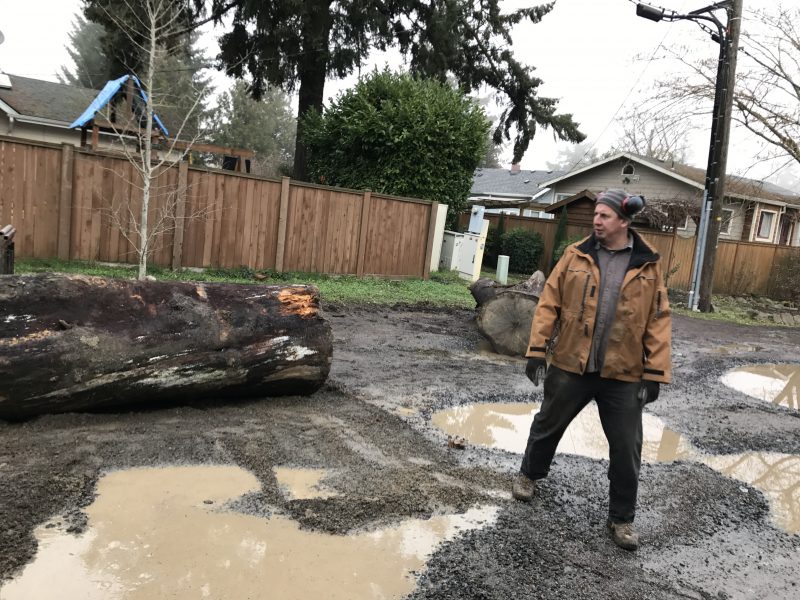
(Photos: Chris Anderson)
This post was originally submitted as a Subscriber Post by long-time BP reader and supporter Chris Anderson.
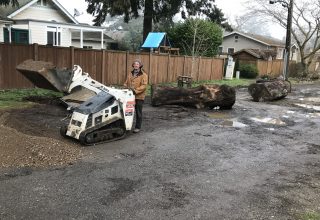
Portland is full of unpaved and unimproved or deteriorating roadways. While a nuisance and a sign of disrespect from City Hall to some, many of us feel these streets are an element of our city’s character to be celebrated. But at the same time, a lack of clear policy about how we can make them better leaves these spaces feeling neglected. Neighbors who want to improve their block have to be trailblazers willing to pave their own way.
That’s what I did (without the paving). Here’s my story…
When Portland Bureau of Transportation Director Leah Treat said streets should be a “place to play,” in a speech in 2014, I was inspired. We have an unimproved street right outside our house in northeast Portland and there are many small kids in the neighborhood.
So, over the course of a year or so (I finished the project back in January), I worked with PBOT, my immediate neighbors and the Concordia Neighborhood Association Land Use and Livability committee to come up with a design that people liked and that the city could permit.
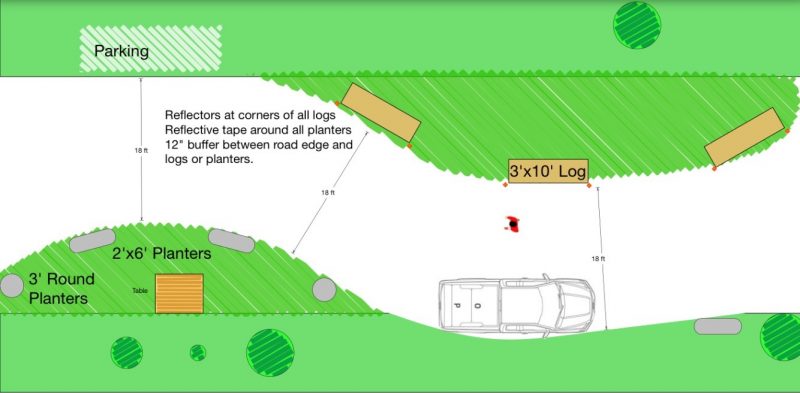
In my case, I drafted a design the neighbors loved but the city couldn’t permit, and then I got feedback from PBOT staff about what type of design they’d support. After a few rounds of design review with the city, I had a drawing ready for neighbor signatures and land use committee approval.
If you embark on a project like this, there are a few key things to keep in mind (based on my many conversations with PBOT):
- You need the buy-in of 75 percent of the adjacent neighbors and/or the neighborhood association. You’ll need to be flexible with the design drawings, so it’s probably more effective to keep the process informal at first.
- You must provide a minimum 18-foot wide automobile pathway (plus one foot of buffer on each side, so it’s really 20 feet.)
- The city policy that supports my project applies to regular paved roads as well.
- A meandering roadway encourages slower driving, so consider making your auto path switch sides of the available space mid-block (see our drawing).
- The logs, planters, and other landscape features you use to delineate the auto pathway need to be shorter than 8-10 feet long (because more massive things are too unforgiving when a drunk person hits them). Speaking of which, you’ll need to indicate reflectors and signage on your drawing.
- Include public space features like tables or gardens.
- The neighborhood association also wanted to make sure pedestrians had easy refuge in the case of reckless drivers in the narrower shared space, so make sure to consider foot paths and bike desire lines as well as play areas.
My project cost about $1,200. We could have gotten the price down considerably if we used donated materials.
Here are a few more photos:
Overall, the process had frustrating stops and starts; but it was well worth it in the end. After everything I went through, PBOT invited me to a meeting with DIY urbanism legends Ridhi D’Cruz from City Repair and Ryan Hashagen of Better Block PDX. The idea of getting us together was to help the City establish a smoother process for other people who want to do similar “place-making” projects in the future.
By the time you read this, it should be much easier to build a play street in your neighborhood. I hope other people give this try! With a few community meetings and a small budget, you can turn a muddy blight into a place where it’s safe for the neighborhood kids to play.
Check out the City of Portland’s Livable Streets program if you want to get started.
— Chris Anderson
BikePortland is supported by the community (that means you!). Please become a subscriber or make a donation today.

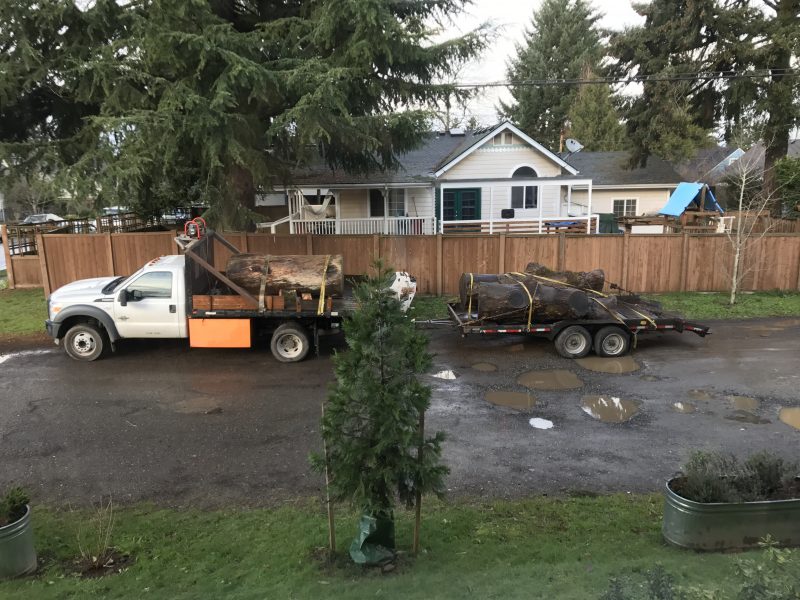
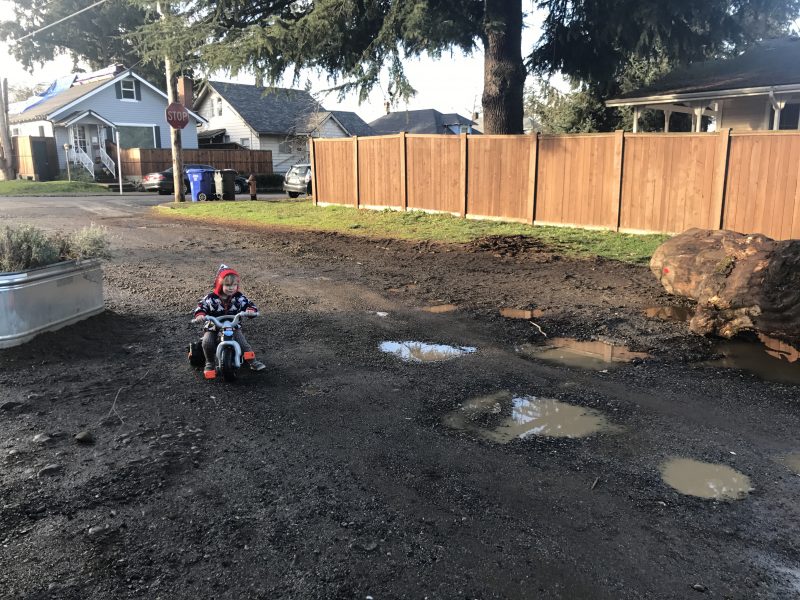
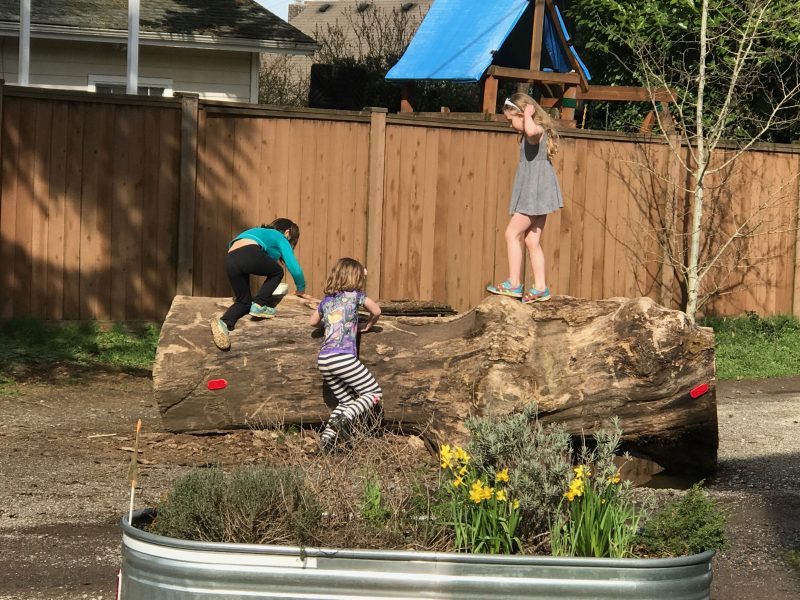
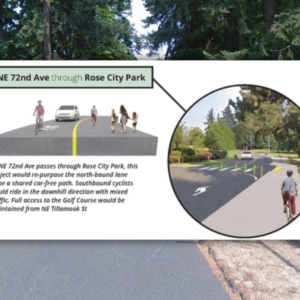
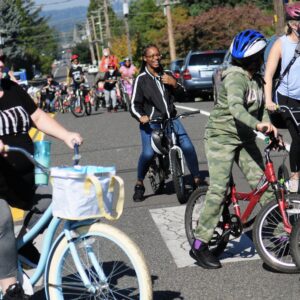
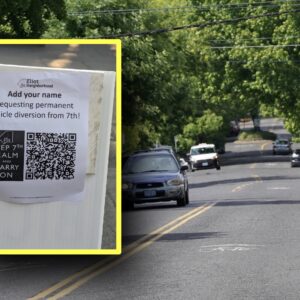
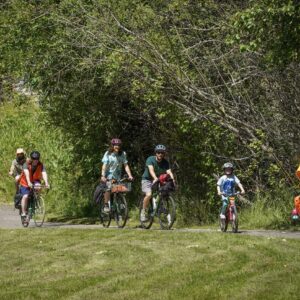
Thanks for reading.
BikePortland has served this community with independent community journalism since 2005. We rely on subscriptions from readers like you to survive. Your financial support is vital in keeping this valuable resource alive and well.
Please subscribe today to strengthen and expand our work.
An interesting fact I didn’t include in the article: The city policy that supports my project applies to regular paved roads as well. So if anyone is as determined as I was, and has supportive neighbors, I’m happy to help with a Play Street project on an improved roadway.
Thanks Chris! I added that to the post.
Does the policy exclude paved streets with transit routes? The reason I ask is that I am not allowed to host a block party on my street since it is on a bus line, so I’m wondering if the play street policy has a similar exclusion.
I don’t know! Probably so, but if you could get Trimet and the neighbors on board, that might be a different story. Maybe make transit shelter or seating part of the project plan?
Any paved streets are eligible? Or just those lacking curbs/sidewalks but that are paved down the middle?
We really need something like this on/near my street in NE. We have sidewalks, but one block away, none. People cut through our street at dangerous speeds in order to bypass a controlled intersection. The city added a stop sign, but on the wrong street for the traffic problem. 🙁
Very cool! I love it !
Very cool, Chris! Congratulations. It’d be really helpful if you could address the nuts-and-bolts administrative process side of things in some detail. Is this as simple as an encroachment permit? If so, where does “neighborhood buy-in” come in–i.e. what are they signing? What does it cost? Timeline? I have some knowledge of the encroachment permit process, but a step-by-step for this particular project would be awesome (I note the Livable Streets age has nothing useful on it, as far as I can find).
Thanks Gary. My impression is that I used bluster and determination on my end to make up for the lack of process on their end. But that the Livable Streets program has a goal of streamlining my experience. So here is a step-by-step that a least gives you the basics for setting expectations:
* First, make a design drawing and show it to your neighbors and/or N.A. Address their concerns without getting too detailed.
* Second, email the contact from the Livable Streets page with your design and make it very clear that your neighbors are already involved and excited. In my case the expensive Encroachment Permit fee was waived because it is a community project.
* They’ll probably want to have a phone call where they tell you the official version of the guidelines I put in this post above.
* Once your design is ballparked, there is a committee at PBOT that meets about Encroachment Permit stuff, I think every other week. So you’ll need for them to make an official determination. And if that committee starts asking for feedback, now you are looking at 2-week review cycles. You are going to have to drive this process from the outside, so maybe ask your contact when the next review meeting is and call them the day before, etc.
* Once your design passes review, you need to get the official neighborhood signatures. There is a PDF they’ll send you for that. Now is also a good time to visit your Neighborhood Association or NA Land Use committee.
* Return your signatures and NA vote results to PBOT, and they’ll send you the permit paperwork. You need to get that notarized. The notary and the county filing fee were the only bureaucracy expenses I had to pay, thanks to it being a community project.
* Let PBOT know once you have filed the permit, and tell them when you plan to start constructions, so they can connect you with the street team. Otherwise you might end up with a big STOP WORK sign plastered to your new play area.
* Build it.
* Invite the neighbors to play!
* Set up a block party to celebrate!
Fun. It would take time and methodical determination to follow the steps you’ve outlined. For other neighbors in the city, something like this could be worth the effort. When they have a common project they work on together, I think it can help neighbors overcome various common issues and disputes they may come to have with each other.
When I saw the pictures of this street, a thought that came to me was, this looks like the kind of street where some people tend to park an old junk car or trailer, for the day they’ll eventually sell or ‘restore’ it, and it sits and sits until blackberries and other weeds grow up around it. And where people on a bender, walk through because it’s dark, then hang out around the junk, swig hooch and toss their trash in the ramble.
Great idea to stick with the idea and work to have this street enhance the neighborhood.
Awesome!! Just a note getting a notarization can be free… Just go to your bank and there’s usually a notary on shift.
Is that a newly-planted Incense Cedar tree? They smell nice on the Highway 26 multi-use path.
Western Red Cedar (thuja plicata) I think. Planted by Friends of Trees.
Is that confirmed ? It just looks so much like an Incense Cedar.
Nice project, looks like a good idea. Any idea how many hours you personally have in this? Sounds and looks like a lot. I’m curious about what traffic on the street was like before the reconfiguration, and whether there was much parking on the street.
Obviously, meeting the “…the buy-in of 75 percent of the adjacent neighbors and/or the neighborhood association. …” must have resolved any questions about the availability of parking on the street.
I love the potholes. They can be a real surprise for anyone that hasn’t driven over them before. There is a knack to it though…either straddle them if possible, or go very slow easing the wheel of the vehicle into it, and back out again. Either way, there’s a slowing effect, and that’s mostly good on a neighborhood streets…emergency vehicles, different story.
In the pictures, I don’t see the reflectors on the logs. I hope they’re big enough to clearly see, because I’m guessing this street doesn’t have street lights (works for me…very nice to walk on naturally lit streets at night by the light of the moon when its out.). If someone did drive into one of those big logs, that could be very bad.
Some fill dirt and good topsoil in a berm kind of shape to either side of the logs and under the planters, might even make the treatment more interesting and beautiful. An actual landscape garden could be there. More money and time though.
Anyone have ideas about whether this could apply to Neighborhood Collectors with no sidewalks? The street I have in mind is SE 103rd between Foster & Harold. It’s an awfully wide stretch of pavement that really invites speeding.
103rd in your area has a peculiar history. Neighbors have begged for sidewalks for years, especially after 102nd & 104th got them, to no avail. I suggest you contact the Lents NA for advice and history before you start, if you haven’t already done so – it may save you a lot of grief.
102nd and 104th got them via a Local Improvement District, i.e., they’re paying for them.
Do you have a source for that? My understanding is that there have only been a couple of LIDs actually done in the city. Are these streets them?
Tons of LIDs have happened all over the city, and more people should take advantage of the opportunity. You and your neighbors just have to be willing to pay a portion of the cost (it’s basically split up by adjacent property square footage or frontage length, and payable at low interest rates over 20 years).
https://www.portlandoregon.gov/transportation/35715
I had heard years ago it was FEMA money. My mistake.
Has anyone ever heard of unimproved streets (excuse me, just a bit earlier, I wrote ‘undeveloped’ street…not meaning to confuse.)…having good, solid concrete sidewalks installed, leaving the street surface itself not paved with asphalt or concrete?
To some extent, I’m a fan of walking in the street…right down the middle if it’s a street without much traffic. Tends to be less shadowy there at night. I know also, that walking on an unimproved, muddy or dusty, potholed street, can be tough. Solid, clean sidewalks can be a very welcome amenity, and maybe they, rather than the street surface itself, should be the higher priority when the city and the neighborhoods decide to invest in infrastructure for an unimproved street. To which types of infrastructure are our priorities best placed?
Unpaved streets (dirt or gravel) are rare enough in Portland, but with concrete sidewalks is rarer still. But they do exist. The easiest example is SE 69th, just south of Woodstock, between Martins & Carlton (broken pavement) and Carlton to Tolman (2 separate gravel tracks.) The sidewalks are there, but they are partially buried by local fill, partly by neighbor’s neglect. If you go out there, you’ll notice that nothing really grows well where the sidewalks should be (and are, under a thin layer of dirt.) I’ve seen a few in other parts of Portland too, as well as numerous streets with “substandard” pavement with sidewalks.
“Unpaved streets (dirt or gravel) are rare enough in Portland, but with concrete sidewalks is rarer still. But they do exist. The easiest example is SE 69th, just south of Woodstock, between Martins & Carlton (broken pavement) and Carlton to Tolman (2 separate gravel tracks. …” hampsten
Since you mention concrete sidewalks on a street with broken pavement being one of the streets, and the other having gravel tracks, that’s not quite the example I was wondering whether existed, but from a budget perspective and a walking-biking perspective, those are interesting examples.
Well built roads paved with big rocks can do ok for motor vehicle travel, short distances like a block, not a problem, except slows traffic down. Walking and biking isn’t so good on that surface, so a nice wide sidewalk big enough for easy use by people walking and biking together could work well to the side of a rock paved road.
As I’ve thought through this more, what we really need on 103rd is a safe-feeling pedestrian area, but I don’t think the neighbors will pay for sidewalks (it’s not a rich area). So maybe we could use planters/logs/benches/whatever we can get for cheap/free to delineate a pedestrian area on one side of the asphalt? In the few locations where there are sidewalks, that’s an opportunity for a chicane to slow traffic…. Man, I wish I had more time to push ideas like this. It’s hard to get going when the traffic on the street is a barrier to meeting the neighbors in the first place.
103rd south of Harold is the current neighborhood collector street. You might want to get that changed, if possible, as part of the TSP update.
I’m not sure it would qualify for the street by street initiative:
https://www.portlandoregon.gov/transportation/58466
Where did PBOT get their 18ft wide test car?
When I first placed the planters, I didn’t leave the full buffer, and one got dragged and spun by a garbage truck (I assume). I put it back and added the buffer, and no problems since.
Did you fill the potholes, too?
We’ve filled them a couple of times in the last few years. The potholes are back in a few weeks. If this wasn’t a garbage truck route, the whole story would be different.
The Woodstock neighborhood has a lot of these unimproved roads going East to West. I always thought it would be a great way to make mountain bike single track with rocks and features here. One would almost need to do nothing on some of the roads since the potholes are epic in size.
Map it and publicize it. The ORCMP did not survey public ROW’s that would add greatly to the bike network. Your idea is great and could add loop options throughout the city with technical features for those inclined, all the while adding plants, restoring bird habitat, and creating more green space, EVEN with the presence of mountain bike trails.
Charles,
As fellow Woodstocker and MTBer, I’d love to pitch in on something like this.
Some students at PSU did a good study of the Woodstock unimproved streets a few years back. I think it was appropriately called “Roadway Not Improved.”
Lack of process may not last long. Way back in 2001, I moved to a condo in an inner Melbourne, Australia neighborhood. I needed to get a permit to have two cats rather than one, there was no process, but I wrote my letter, made my justification and got the required permission. Within months, they had a form and a process (which would have been a nuisance to follow) – my impression was that they made the process sufficiently difficult to dissuade all but the most persistent. My expectation is that now that you have broken ground, the city will document a process, how onerous it becomes will depend on whether the city wants to encourage or obstruct the activity.
Good job by all!
Where is this? NE Emerson St?
Great story about someone taking the initiative to do something proactive in the community. Counterpoint to the frustration many feel towards Washington DC.
Are you planning on seeding the dirt areas?
Gravel road work just fine IF there is sufficient drainage. We tend to favor the crown and drain method vs draining the street through the top. I like gravel roads…they slow cars down. Slow cars don’t tend to kill as often.
Nice Work!
The biggest problem in Portland is that the city refuses to maintain any gravel/dirt roads that aren’t paved. So they just get worse and worse and the neighbors are left to fend for themselves. A single grader run over these roads every 4-6 months would do wonders!
And by the city, you mean the taxpayers? Should the general taxpayers pay to maintain roads local residents have not improved?
Yes, That’s what PBOT’s job is. But I know you work for them so you’ll pull out the “residents have always paid for paving streets” line, even though that’s been debunked:
“The policy and the reasoning behind it are spelled out in plain language on PBOT’s website: “The City of Portland does not currently share in the cost of constructing streets or maintaining substandard streets. Since the beginning of the City’s history, most or all of these costs have been paid for by adjacent property owners.”
Of course, that’s not the argument Adams made when he toured Cully and promised to work through the backlog.
But there’s a bigger problem with the city’s policy—it’s based on a total falsehood. That particular version of city history was thoroughly debunked in a report provided to Willamette Week by PBOT itself.
In a 2000 report to City Council about funding for street improvements, an expert panel delved into the history of Portland infrastructure. They called the notion that property owners have always borne the cost of paving streets a “long-standing myth.”
As recently as 2000, the study found, the city was paying most or all of the costs to pave many streets, especially in poorer neighborhoods.
“The implication of this myth was that property owners paid almost entirely for their street, a proposition that is nowhere near the truth,” the report says. “It is much more accurate, and also much more relevant to the problems we face today, to state that property owners have almost always helped pay for at least a portion of the costs for improving their streets.””
http://www.wweek.com/portland/article-17460-dirt-roads-dead-ends.html
Regardless of past practice, it is current policy – local residents paying to improve local streets. If you want PBOT to return to building local streets, you’ll need to get the current policy changed. PBOT has changed requirements for local street improvements so that the one size fits all model is no longer required, but I don’t see a lot of public support to spend limited resources on the lowest level of auto infrastructure.
It is a lot more accurate to say that PBOT policy is that if neighbors want an unpaved local street paved, they’ll need to form an LID. But if the city wants a local unpaved street paved, they’ll find the means and money to do it.
A prime example is along the future HOP bike way in East Portland. On Oregon between 110th & 111th is a gravel section, as well as on Holiday at 120th. Both sections were recently added to the new 2017 TSDC project list as being eligible for TSDC funding up to 100% of the costs. In addition, the fully-funded 150s bike way also has gravel sections which are also eligible for SDC funding. There are numerous sections throughout East Portland and Cully that are now on this list, all of which are obviously local streets.
Not sure what your point is. Sure, PBOT improves streets as part of another program, Greenways, Safe Routes, etc., without regard to their classification. PBOT also installed a signal on Division at 86th, and a PHB on 122nd at Bush – all part of other projects.
From the TSDC project list, project # 50047: Design and implement a neighborhood greenway. Project includes crossing improvements at 102nd and 122nd and improvement of gravel streets at Oregon (110th – 111th) and Holladay (118th – 119th).
Link to list: https://www.portlandoregon.gov/transportation/article/636788
Link to map: https://www.portlandoregon.gov/transportation/article/636790
It’s crazy how even a small project like this can become intensely political. I love that you stuck with it and pulled it off.
More streets should be like this (the winding, play aspect). It naturally slows drivers down.
Impressed with the initiative here, but I do worry that this approach normalizes unimproved streets (more heavily prevalent in lower income neighborhoods). Many of these streets need to either be improved (paved) or closed as an official street. A PSU project in Woodstock years ago made some designs to do similar things to this project and I’ve often heard it referenced from city hall as a “solution” to our backlog of unimproved roads. I agree that in some places it would be great, but that’s not the solution for all of the unimproved roads in Portland and frankly is just PBOT passing the buck.
“…but I do worry that this approach normalizes unimproved streets (more heavily prevalent in lower income neighborhoods). Many of these streets need to either be improved (paved) or closed as an official street. …” serider
Which of the streets you refer to do you feel need to have the decision made that you suggest? Asphalt and concrete paved streets aren’t always necessary, and avoiding that surface treatment if it’s not truly necessary, helps to reduce the infrastructure load the city has to maintain using city residents tax dollars.
Indication is, that the undeveloped street that Chris Anderson an his neighbors worked together on making into a more livable street, wasn’t used a lot for motor vehicle travel, but he’s not saying anythng about that, so we have to guess.
I’d guess the street wasn’t used a lot for motor vehicle travel, except maybe for some people on a wild hair, deciding to charge over the street with its potholes, testing out their four-wheel drive, for example. With vehicles bumping and jumping around fast on a deep potholed surface, that kind of thing obviously poses a danger to anyone that might be out on the street walking, or playing, and so on.
Creating a narrower, curvy alignment, rather than a straight shot, seems like a treatment that might discourage neighborhood and road abuse, and still allow necessary traffic to pass through. It’s a good idea basically, if the street isn’t required to handle a lot of vehicle traffic, and as long as the street doesn’t need to be straighter and smoother for emergency vehicle use.
If the street is not marginally maintained (as a dirt and gravel street) it absolutely needs to be paved in our climate. Otherwise you end up with what almost all of these streets are, giant mud pits with crater-sized puddles making them only passable for 4WD vehicles for much of the year and very inhospitable to pedestrians.
SE Rider, wsbob, & paikiala, PBOT is already ahead of you on this. They have somehow figured out a way to spend their massive $30 million accumulation of TSDC (Transportation System Development Charge) money of some of the unpaved street segments, mostly in poorer districts, with bike and pedestrian connections being prioritized. In addition, they have secured various state, Metro, and federal grants, as well as SR2S and city gas tax funding, for many of these projects.
Link to TSDC list: https://www.portlandoregon.gov/transportation/article/636788
Link to TSDC map: https://www.portlandoregon.gov/transportation/article/636790
By no means does this fix all the unpaved streets, or anything close to it. In many cases, the streets lead nowhere; in many other cases, the immediate adjacent neighbors don’t want the streets fixed, as they slow through traffic with the huge potholes the “natural traffic calming”. However, in poorer districts, when the city feels a need to fix a street, they will find the ways and means to do it, even if it takes them 3 decades to do it. In wealthier areas and near industrial sites, PBOT continues to push its LID process.
Portland taxpayers can no longer afford to build streets the way they did 50-100 years ago, in addition to which that way of building has run-off impacts that are also expensive. Unpaved may not be ideal, but 36 feet of impervious with curbs, sidewalks, storm drains and pipes is the other extreme.
So I take it you’re not into the shared streets designs?
I’m quite in favor of them, as well as pedestrian corridor improvements with structurally designed gravel streets. Curbs are 19th century.
My way of thinking is a bit round-about. Play Streets will be seen as amenities. So neighborhoods that implement them will draw higher housing prices, etc.
If parts of the outer east side increase their quirkiness enough, it will make the city more affordable. Because currently newcomers write whole sections off the city off as not being “Portland enough.” So if we can multiply the land area that counts as Portland in the eyes of these buyers, we’ll lower housing price pressure in the central city, and make it more likely that non wealthy folks can afford to stay in inner neighborhoods.
I’m not being super articulate, just saying economically diverse neighborhoods are good, and that Play Streets in East Portland might make the area more appealing, reducing the pressure on the relatively tiny geographic area that people think of as Portlandia today. There are questions about who benefits when a neighborhood becomes more appealing, but if making it safe for kids to play in the street is wrong, I don’t want to be right.
That’s a great point. I just worry about areas where the unimproved roads are so common, and the grid is so incomplete. Woodstock is a great example: There isn’t a paved through street parallel to Woodstock for almost half a mile in either direction. And Woodstock itself is sketchy for many (esp. with kids) to ride bikes (no bike lanes or sharrows, just a “25 mph” speed limit), but there is no other option if you want to get to Woodstock (or even just get through Woodstock). In moderation I think these types of play streets are great, I’m just worried PBOT will just suggest that all unimproved roads become play streets.
As for affordability, my wife is in real estate and has a lot of first time buyers in the mid-mid-lower range and it seems like for at least the next couple of years that ship has sailed. It’s hard to find stuff even in the most unimproved parts of town for under $275K-$300K. But you’re right, play streets may draw a few people out of the $700-800K part of town.
These streets could be local MTB trail options also. As a neighbor, I would much rather have kids and adults riding bikes past on my pot holed street than having cars and trucks racing through to Clackamas. A little dirt and lumber goes a long way.